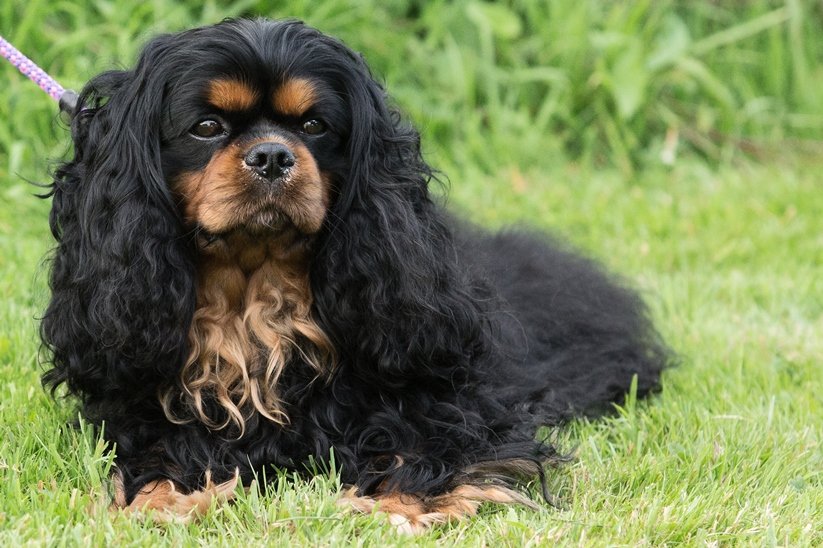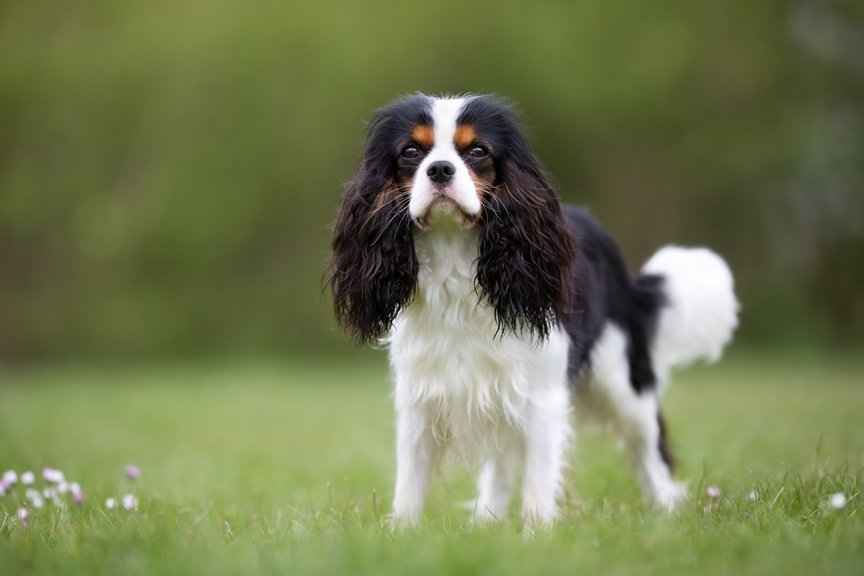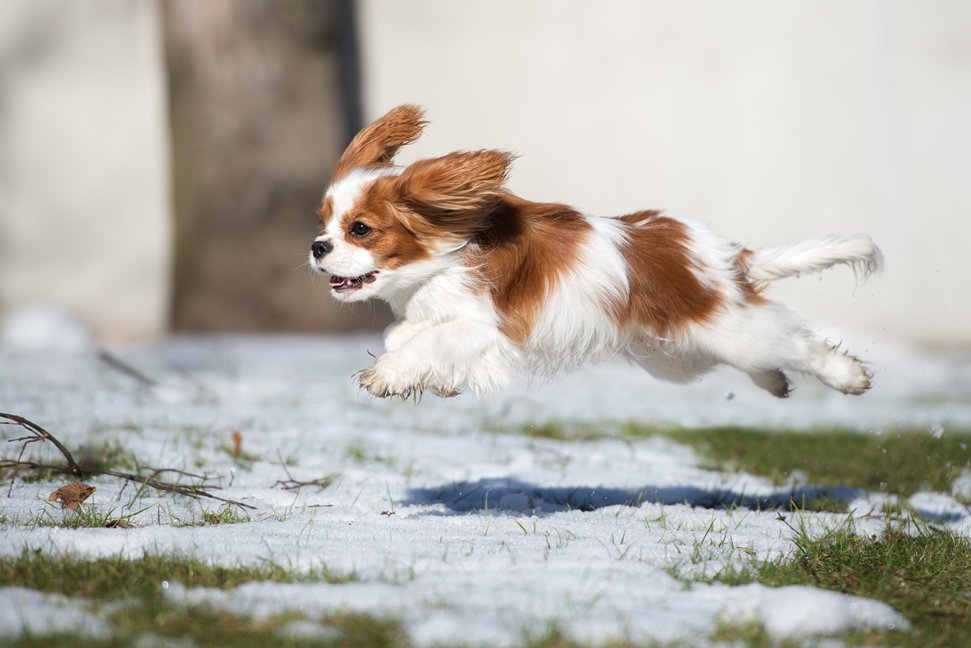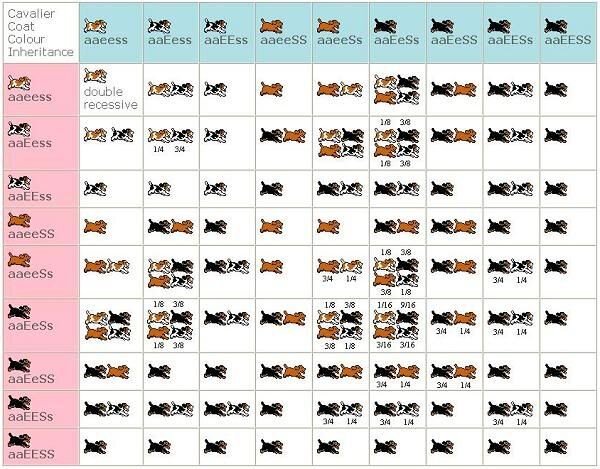One of the Cavalier’s great charms are their beautiful coats. There are only 4 recognised colours for the breed; this is because many of the genes which control coat colour are fixed in the Cavalier. It’s possible (although it’s not very common) to have litters comprising all four colours, depending on the puppies’ genetic inheritance. But how can you predict – with any degree of accuracy – how to choose a mate for your Cavalier which will give you the best chance of producing puppies of the colour you want?
Well, there isn’t – as yet – a genetic test available specifically for Cavalier coat colours, although there are genetic tests available for many of the individual genes on the number 2 chromosome which controls the composition of a dog’s coat colour. But to understand how these genes interact it’s necessary to dive into the basics of genetic inheritance.
It’s lucky that the genetics of the four recognised Cavalier coat colours is relatively simple – and predictable, within limits. But to start with you need to understand some basic genetic terms.
Basic Genetic Terms
Chromosome – a coiled structure of DNA containing many genes which dictate the hereditary constitution of a dog; its physical appearance and genetic makeup. Dogs have 78 chromosomes: 38 pairs of diploid genes and 2 sex chromosomes. (Humans have only 46 chromosomes. We are simple people.)
Gene – a unit of DNA that governs a particular trait. In most cases more than one gene can influence the same trait and such traits are known as polygenic. They are also known as ‘complex’ traits. But some traits are controlled entirely or primarily by just one gene, and these are referred to as monogenic or ‘simple’ traits. Coat colour is a complex trait; one which is a composition of the effects of many genes.
Locus – the exact position on a chromosome where a specific gene is located. Genes are arranged in a particular sequence and each gene has a particular location on its individual chromosome.
Allele – one form of a particular gene. Each parent passes one allele to their offspring and the result depends on this combination. It’s common for people to use the word gene when they mean allele. There are two alleles in one gene: one from the mother and one from the father. There may be more than two variations of alleles possible for any gene, but an individual dog can only inherit two.
It’s possible for all dogs in a breed to have the same allele for one gene; in this case the allele is said to be fixed.
Dominant – an allele which blocks out the other allele from the same gene. A dog displaying a dominant trait (e.g. black colour coat in Labradors) may be double dominant or pure or clear (BB) or a carrier (Bb). In the same way Solid colour (S) is dominant over all variations of white, which dominate each other in the order shown below:
- si (Irish-white pattern, as in collies or boxers)
- sp (piebald white pattern, like Blenheim and Tricolour Cavaliers)
- sw (extended white pattern, as in Clumber spaniels)
Recessive – an allele which is hidden by the dominant allele. The sp (particolour) allele in Cavaliers is recessive to the S (wholecolour) allele. A Tricolour or Blenheim Cavalier must be spsp; if he had a S allele he would be a wholecolour. The term recessive has nothing to do with whether a trait is good or bad, or how frequently it occurs in a breed. It simply means its effect is cancelled out by the dominant allele.
Genotype – the alleles an individual possesses. SS is a different genotype from Ssp, which are both different from spsp.
Phenotype – the physical appearance and visible characteristics of an individual. SS and Ssp dogs have the same phenotype (they are both wholecolours). However, spsp dogs have a different phenotype than either of the others (they are particolours).
Homozygous – both alleles within the gene are the same; that is Cavaliers with SS and spsp genes are both homozygous. These dogs might be referred to as pure or clear or breed true wholecolours or particolours. It’s impossible to tell by its appearance whether a dog displaying dominant characteristics is homozygous or heterozygous, whereas you always know that a dog displaying recessive characteristics is homozygous recessive.
Heterozygous – this dog has two different alleles for a particular gene; that is, Ssp. These dogs are carriers for the particolour allele, although their phenotype is wholecolour.
How the Cavalier Coat Colour is Composed

This is an area which is still imperfectly understood but the A or agouti gene sets the base colour in dogs (and cats and horses and other animals). The base colour for most Cavaliers is black and tan (at at), although there is a rare recessive a variant, which we will return to later. The Cavalier coat colour variations are all drawn from other genes. Coat colour is complex trait.
For example: the allele G codes for grey (as in Dandie Dinmont Terriers) while the allele g codes for normal (i.e. non-grey) colour. In the Cavalier, however, the allele is always G; the same is true for the D code (dark coat colour diluted to blue in Great Danes – dd), nearly always true for the B code (black coat colour diluted to brown: chocolate Labradors are bb; more about that later) and the dominant merle (which also causes vision and hearing defects. That’s why a merle-carrying dog should never be bred to another merle-carrying dog. All Cavaliers are mm – non-carriers).
This means we don’t need to concern ourselves with any of these combinations. The ones which you need to understand are these.
The Extension Gene
The most important gene affecting the Cavalier’s coat colour is the extension gene. This gene may have multiple alleles (research is ongoing) but only two affect Cavaliers.
- E – no effect on the agouti gene
- e – a golden or red coat (with no black tipping on the hairs)
The e allele is responsible for the golden colour of Golden Retrievers, the solid red of Irish Setters, and the red of Ruby and Blenheim Cavaliers. Other modifying genes control the shade the of hue, which can range from cream to deep ruby red (a deep red is preferable for Cavaliers).
So now we have 3 possible genotypes for Cavaliers:
- at at EE – black and tan (homozygous)
- at at Ee – black and tan (heterozygous)
- at at ee – ruby (always homozygous)
Although black-and-tan is often referred to the ‘dominant’ Cavalier colour, it is more complex than that as one gene (the agouti) cannot be dominant to another gene (the extension). It is the E (not-red) allele which is dominant to the e (red) allele. The black and tan colour is always present; it is the makeup of the E/e gene which decides whether or not the colour of the agouti gene is expressed. In genetic terms the ee genotype is epistatic to any colour otherwise expressed by the agouti gene. So the base colour of a dog with the ee genotype will be red.

The Spotting Gene
We have already met the spotting gene when discussing dominant genes (this is the S/sp variation). The spotting gene controls how much, if any, white appears in the Cavalier’s coat. Where the recessive allele is homozygous (i.e. sp sp) the dog will be particoloured.

So in all there are 9 possible genotypes for the Cavalier:
- at at EE SS – black and tan (homozygous)
- at at EE Ssp – homozygous black and tan carrying particolour gene
- at at Ee SS – black and tan carrying red but homozygous wholecolour
- at at Ee Ssp – black and tan but carrying red and particolour genes
- at at ee SS – ruby (always homozygous) and homozygous wholecolour
- at at ee Ssp – ruby (always homozygous) and carrying particolour gene
- at at EE spsp – tricolour (homozygous)
- at at Ee spsp – tricolour carrying red gene
- at at ee spsp – Blenheim (always homozygous)
The effects of the spotting gene are not entirely understood; it is very common for a ‘wholecolour’ to have splashes of white, usually on the chin and/or chest. It’s not known exactly what causes this small distribution of white coat to occur; but although wholecolour puppies with particolour parents are especially prone to it, two solid wholecolours can produce such puppies too.
Blenheims and tricolours can also be very heavily marked, with torsos that are almost entirely black or ruby, with the white coat confined almost entirely to the legs, face, chest, belly and tail. Clearly there is more to be learned about the genetic patterns which lie behind the distribution of white hair on the Cavalier. There may well be other as yet unknown genes involved.
Of the two particolours Tricolour is dominant in the same way as black and tan is dominant over Ruby. Mating a dominant (homozygous) tricolour to a Blenheim will produce only tricolour puppies, but all those puppies will carry the Blenheim gene and therefore will be heterozygous Tricolours. It can take more than one generation to achieve the results you want.

How the Cavalier Coat Colour is Inherited
When two Cavaliers are mated the dominant characteristics will win out over the recessive. This means a dominant tricolour mated with a dominant solid ruby will produce – black and tan puppies!
Two Blenheims will always have only Blenheim puppies (the Kennel Club will not register the non-Blenheim offspring of two Blenheim parents).
This chart shows the possible colour combinations from all the possible genetic combinations.

While the genetic makeup of some Cavaliers can be known from their colour alone (i.e. Blenheims) or their parentage (e.g. the tricolour offspring of a tricolour and a Blenheim will always be a homozygous particolour carrying the red (Blenheim) gene); many can only be ascertained through sustained breeding, and even then not always with complete confidence.
Is your tricolour a dominant tricolour?
Mate the dog with a Blenheim. If the result is string of tricolours (e.g. 8-12) with no Blenheim in sight then yes, you probably have a dominant tricolour. But there’s still that 1% element of doubt. It’s the same with a black and tan. If there are no rubies after two large litters then you probably have a dominant black and tan. But if you want proof you will need to carry out a DNA test for colour inheritance.
The Forgotten Colours
In 1973 the Kennel Club amended the breed standard to recognise only the four Cavalier colours we have covered. Up until then all colours were recognised, which included two rare but historically known colours which continue to pop up from time to time through recessive genetic inheritance. There are two genes responsible for these anomalies; both recessive and both touched on previously.
The first is the rare a version of the A or agouti gene. This produces either a solid black or a black and white Cavalier, depending on the spotting gene. The other is an equally rare b version of the B or black gene, which produces a chocolate and tan wholecolour or a chocolate tricolour, again depending on the spotting gene. If a bb dog is a ruby or a Blenheim it will have a chocolate nose and paws.
These dogs are perfectly genuine Cavaliers, but until recently they could not be registered as the Kennel Club does not recognise them (they are now accepted as ‘colour not recognised by the Kennel Club’). Nevertheless they have a small but devoted following, and recently there has been a revived interest in breeding chocolate Cavaliers, mostly in America.


A black and a wholecolour chocolate Cavalier
As these genes are recessive it is impossible to know how many strains remain in today’s Cavalier lines. For black or chocolate puppies both parents need to be carrying the recessive a or b gene, and these genes are too scattered for most matings to produce such colours. But it is possible to test for them now, which may in time give a better idea of how much of such strains remain.



